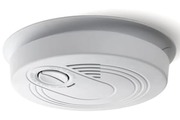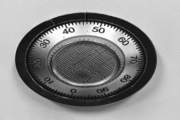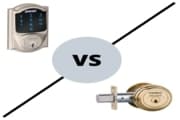Lock Durability
MAY 27, 2016
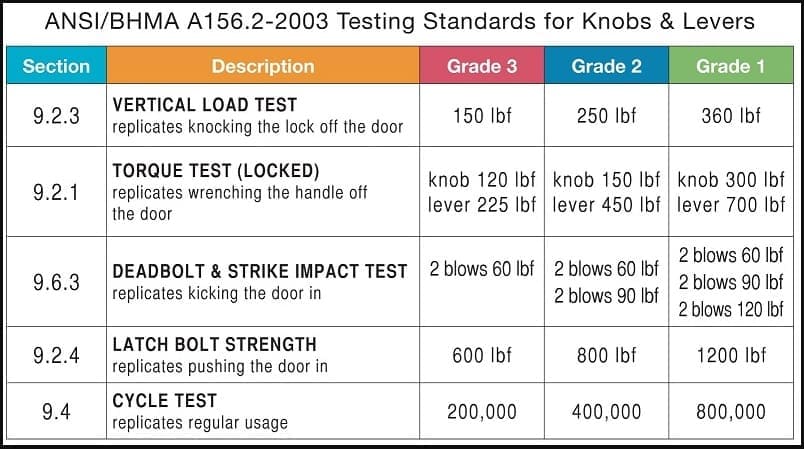
ANSI*/BHMA** standards set forth different product grades for door hardware products. These product grades are defined by progressive levels of performance benchmarks in each applicable standard.
*American National Standards Institute **Builders Hardware Manufactures Association
The ANSI/BHMA industry standards exist to help identify the quality and durability of lock sets via a series of operational and security tests. Following is a guide to how the standards are set. BHMA (Builders Hardware Manufacturers Association) is accredited by the American National Standards Institute (ANSI), a private non-profit organization that administers and coordinates the voluntary standardization to develop and maintain performance standards for builder’s hardware.
- Grade 3 Good: Light Weight Residential Security(indoor use)
- Grade 2 Better: Light weight Commercial and Heavy Duty Residential
- Grade 1 Best: Heavy Duty Commercial Use
- Operation i.e.: key torque; duty cycles
- Security i.e.: pull strength, impact resistance and finish
- Grade 1 – Highest Grade Security The strongest grade ANSI recognizes for any residential or commercial product.
- Grade 2 – Higher Residential Security Designed to offer excellent security and durability. Used mostly for residential applications and some light commercial applications.
- Grade 3 – Basic Residential Security The lowest grade provided by ANSI, and the minimal acceptable quality for residential door locks.
So what does this mean to me?
Each grade specifies minimum acceptable requirements for:
ANSI /BHMA Impact Resistance Chart - “The Impact Test”
The ANSI and the BHMA created three grades for locks, numbered 1, 2 and 3, based on the quality, performance and features of the lock.
| Grade | Test |
|---|---|
| Grade 1 – Superior Strength | Must withstand 8 total blows: 2 blows @ 60 lbs. of force 2 blows @ 90 lbs. of force 2 blows @ 120 lbs. of force 2 blows @ 150 lbs. of force |
| Grade 2 – Acceptable Strength | Must withstand 6 total blows: 2 blows @ 120 lbs. of force 2 blows @ 90 lbs. of force 2 blows @ 60 lbs. of force |
| Grade 3 – Low Strength | Must withstand 4 total blows: 2 blows @ 90 lbs. of force 2 blows @ 60 lbs. of force |
| Not Graded – Severe Risk | No impact standards |
Grade 1, 2, 3 Specifications
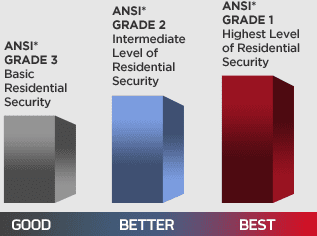
Each grade specifies minimum acceptable requirements for operation, key torque cycles, pull strength, impact resistance and finish.
Single Cylinder:
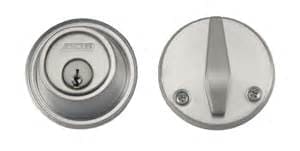
The most commonly used deadbolt. A simple deadbolt lock which is opened from one side with a key while there is a thumb piece in the interior side. From the inside the door can be locked or unlocked by simply turning the thumb turn mechanism.
Double Cylinder:
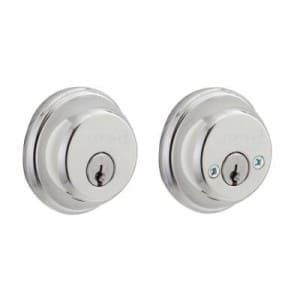
A keyed cylinder on both sides of the door requiring a key to unlock the door from both sides. These can be used in the situation where there is a breakable glass near the knob. Keep in mind that in an emergency you’d have to find your key before being able to unlock the door and escape. Some building codes commonly ban the use of double cylinder deadbolts on doors used in the path of egress (outside doors) because they can prevent rapid exit in case of fire or other emergency.
From the Blog



